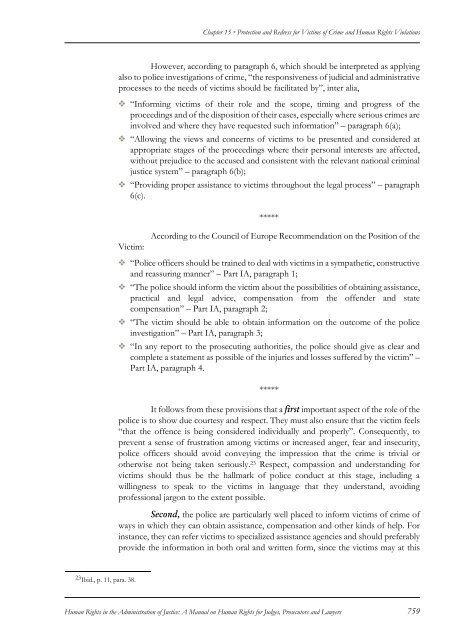protection and redress for victims of crime and human rights violations
protection and redress for victims of crime and human rights violations
protection and redress for victims of crime and human rights violations
You also want an ePaper? Increase the reach of your titles
YUMPU automatically turns print PDFs into web optimized ePapers that Google loves.
Chapter 15 • Protection <strong>and</strong> Redress <strong>for</strong> Victims <strong>of</strong> Crime <strong>and</strong> Human Rights ViolationsHowever, according to paragraph 6, which should be interpreted as applyingalso to police investigations <strong>of</strong> <strong>crime</strong>, “the responsiveness <strong>of</strong> judicial <strong>and</strong> administrativeprocesses to the needs <strong>of</strong> <strong>victims</strong> should be facilitated by”, inter alia, “In<strong>for</strong>ming <strong>victims</strong> <strong>of</strong> their role <strong>and</strong> the scope, timing <strong>and</strong> progress <strong>of</strong> theproceedings <strong>and</strong> <strong>of</strong> the disposition <strong>of</strong> their cases, especially where serious <strong>crime</strong>s areinvolved <strong>and</strong> where they have requested such in<strong>for</strong>mation” – paragraph 6(a); “Allowing the views <strong>and</strong> concerns <strong>of</strong> <strong>victims</strong> to be presented <strong>and</strong> considered atappropriate stages <strong>of</strong> the proceedings where their personal interests are affected,without prejudice to the accused <strong>and</strong> consistent with the relevant national criminaljustice system” – paragraph 6(b); “Providing proper assistance to <strong>victims</strong> throughout the legal process” – paragraph6(c).*****Victim:According to the Council <strong>of</strong> Europe Recommendation on the Position <strong>of</strong> the “Police <strong>of</strong>ficers should be trained to deal with <strong>victims</strong> in a sympathetic, constructive<strong>and</strong> reassuring manner” – Part IA, paragraph 1; “The police should in<strong>for</strong>m the victim about the possibilities <strong>of</strong> obtaining assistance,practical <strong>and</strong> legal advice, compensation from the <strong>of</strong>fender <strong>and</strong> statecompensation” – Part IA, paragraph 2; “The victim should be able to obtain in<strong>for</strong>mation on the outcome <strong>of</strong> the policeinvestigation” – Part IA, paragraph 3; “In any report to the prosecuting authorities, the police should give as clear <strong>and</strong>complete a statement as possible <strong>of</strong> the injuries <strong>and</strong> losses suffered by the victim” –Part IA, paragraph 4.*****It follows from these provisions that a first important aspect <strong>of</strong> the role <strong>of</strong> thepolice is to show due courtesy <strong>and</strong> respect. They must also ensure that the victim feels“that the <strong>of</strong>fence is being considered individually <strong>and</strong> properly”. Consequently, toprevent a sense <strong>of</strong> frustration among <strong>victims</strong> or increased anger, fear <strong>and</strong> insecurity,police <strong>of</strong>ficers should avoid conveying the impression that the <strong>crime</strong> is trivial orotherwise not being taken seriously. 23 Respect, compassion <strong>and</strong> underst<strong>and</strong>ing <strong>for</strong><strong>victims</strong> should thus be the hallmark <strong>of</strong> police conduct at this stage, including awillingness to speak to the <strong>victims</strong> in language that they underst<strong>and</strong>, avoidingpr<strong>of</strong>essional jargon to the extent possible.Second, the police are particularly well placed to in<strong>for</strong>m <strong>victims</strong> <strong>of</strong> <strong>crime</strong> <strong>of</strong>ways in which they can obtain assistance, compensation <strong>and</strong> other kinds <strong>of</strong> help. Forinstance, they can refer <strong>victims</strong> to specialized assistance agencies <strong>and</strong> should preferablyprovide the in<strong>for</strong>mation in both oral <strong>and</strong> written <strong>for</strong>m, since the <strong>victims</strong> may at this23 Ibid., p. 11, para. 38.Human Rights in the Administration <strong>of</strong> Justice: A Manual on Human Rights <strong>for</strong> Judges, Prosecutors <strong>and</strong> Lawyers 759
















